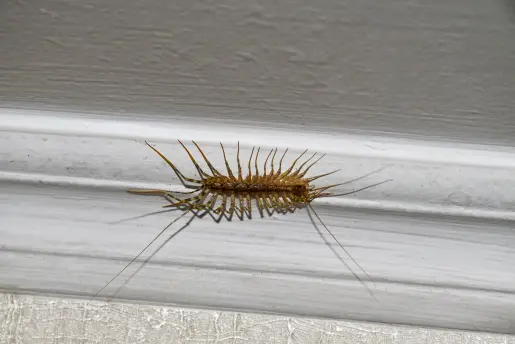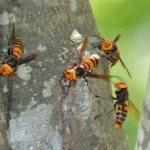
What’s Drawing House Centipedes to Your Home?
With their frantic movements and many legs, house centipedes can easily catch you off guard. These swift arthropods, known scientifically as Scutigera coleoptrata, aren’t trying to harm you. They don’t bite or sting humans, but their sudden appearances can certainly be unsettling.
So why are they showing up in your home? The answer usually comes down to survival. When your home provides food, moisture, and places to hide, it becomes a favorable home for these pest-hunting invaders.
How Do They Sneak Indoors?
House centipedes don’t need a wide-open door to get inside. Small cracks in your foundation, unsealed window frames, gaps around plumbing, and uncovered vents give them more than enough access. Once inside, they look for damp, cool areas with minimal human activity, places where insects gather and they can remain hidden.
Because they’re nocturnal, centipedes often go unnoticed for a while. You’re most likely to find them in areas like basements, bathrooms, or crawl spaces, anywhere that stays dark and moist.
Centipedes Love to Follow Bugs Inside
Centipedes aren’t randomly choosing your house, they’re on the trail of their next meal. Before they ever set foot indoors, they live in shady garden beds, under piles of wet leaves, or beneath rocks. When the insect populations they feed on start to shift toward your home, centipedes follow the food.
If you’re spotting them indoors, it might mean there’s a hidden pest problem brewing. House centipedes eat a wide range of common insects, including:
- Ants
- Bed bugs
- Cockroaches
- Crickets
- Earwigs
- Moths
- Silverfish
- Spiders
- Termites
- And many more
Damp Conditions Keep Them Coming Back
Moisture is a magnet for house centipedes. Outdoors, they thrive in soggy mulch, wet soil, or decaying organic matter. Indoors, they’re drawn to poorly ventilated spaces, leaking pipes, and rooms with high humidity.
Want to make your home less welcoming? Managing moisture is the key. Try these preventive steps:
- Repair leaking spigots, hoses, and exterior plumbing.
- Clean out your gutters and make sure downspouts divert water away from the home.
- Trim thick shrubs and overgrown plants to let sunlight dry the soil.
- Run dehumidifiers in damp basements, laundry rooms, or closets.
- Ventilate bathrooms properly to reduce steam buildup.
Cluttered Spaces Give Them a Place to Hide
Centipedes avoid bright lights and busy areas. Instead, they tuck themselves into quiet corners, under piles of clutter, or inside outdoor debris where they’re unlikely to be disturbed. If your yard or home has plenty of hiding places, they’re more likely to stick around.
You can reduce their interest by making a few changes:
- Store firewood off the ground and a few feet away from your home.
- Clear out clutter such as unused tools, broken furniture, or leftover construction materials.
- Don’t leave toys or lawn equipment out, moisture collects beneath them.
- Rake and remove fallen leaves regularly to reduce pest harborage.
- Keep your lawn neat and trim tall weeds around your foundation.
- Seal small gaps or cracks around doors, windows, and utility lines.
- Replace torn window screens and worn-out weatherstripping.
House Centipedes Begin Their Lives Outdoors
Although house centipedes are often seen darting across floors or vanishing into drains, they don’t originate inside your home. These pests are initially found outdoors, thriving in damp, shaded places where they can hide and hunt undisturbed. You’re most likely to find them in decaying logs, leaf piles, garden mulch, or tucked beneath landscaping stones.
One of their preferred habitats is the cool, moist soil along your home’s foundation. This narrow zone supports plenty of insect life, offering an ideal hunting ground. Once house centipedes are comfortable near the exterior, it doesn’t take much for them to move indoors, especially during stretches of dry or hot weather.
If you’re trying to keep them out, start with these common outdoor hiding spots:
- Shrub beds and floral plantings: These areas attract soft-bodied insects like aphids that centipedes love to eat.
- Landscaping features like bricks or pavers: Bugs gather underneath these hard surfaces, creating a consistent food source.
- Unsealed or overflowing trash bins: The scent of decay draws in flies and spiders, which centipedes pursue as prey.
A damp, disorderly yard doesn’t just welcome pests, it also welcomes the predators that feed on them.
Are House Centipedes a Reason to Worry?
Their sudden appearance can be unsettling, but house centipedes usually pose no real danger. They’re not aggressive and will retreat quickly if disturbed. Most of the time, they’re just passing through, looking for food and quiet places to rest.
That said, avoid picking them up when possible. Like other centipedes, they carry venom to subdue their prey and could use their front legs to deliver a quick pinch when threatened. The sensation is similar to a bee sting, brief, sharp, and uncomfortable, but rarely serious.
However, individuals with known sensitivities to insect venom could experience stronger symptoms such as dizziness, breathing trouble, or swelling. In those situations, seek immediate medical attention.
While they’re not considered dangerous to most people, it’s still best to steer children and pets away from them.
Identifying a House Centipede
Not all centipedes look alike, and the house centipede has some unique features that make it stand out. Here’s how to recognize one if you’ve seen an unknown centipede:
- Leg appearance: They have long, wispy legs that extend outward, giving them a spider-like shape.
- Leg count: With 15 pairs of legs, they have fewer legs than many of their larger relatives.
- Speed: House centipedes are remarkably fast, often moving more than a foot per second.
- Body color: Their coloring is typically grayish-yellow, with three dark lines running through the length of their body.
- Antennae: Long and thread-like, their antennae help them detect vibrations in dark, tight spaces.
- Behavior: Skittish by nature, they avoid human interaction and rarely make a stand.
- Venom potency: Their venom is mild and generally harmless to people unless an allergic reaction occurs.
Even One Centipede Could Mean You Have More Pests
Catching a glimpse of a centipede might not mean you have a centipede problem, but it likely means you have bugs in your home. These arthropods stick around only when there’s enough prey to support them. Their presence often signals that a hidden insect infestation is already underway.
Squashing the centipede won’t solve the issue. To truly get rid of them, you’ll need to uncover what’s drawing them in and cut off their food supply.
That’s where professional help makes a difference. Our team can inspect your home, identify pest activity, and design a targeted plan that addresses the root of the problem, not just the symptoms.
Contact us today to schedule your inspection and take the first step toward a centipede-free home.





